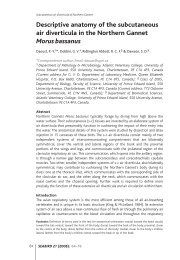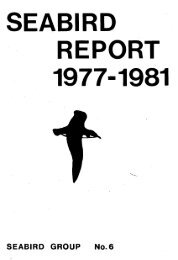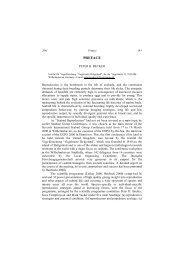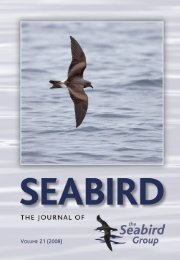Vol 6 No. 2 - The Seabird Group
Vol 6 No. 2 - The Seabird Group
Vol 6 No. 2 - The Seabird Group
Create successful ePaper yourself
Turn your PDF publications into a flip-book with our unique Google optimized e-Paper software.
2004 Feeding ecology and growth of young Guillemots 59<br />
elsewhere (Harris & Wanless 1985; Hatchwell 1991; Bryant et al. 1999; but see<br />
Burger & Piatt 1990).<br />
Chicks were fed a higher proportion of sandeel during the entire chick<br />
rearing periods of 1999 and 2000 compared to 1998. Large increases of juvenile<br />
sandeel abundance were recorded over the Grand Banks in 1998 and 1999<br />
(Anderson 2001), which may have contributed to the increase in adult sandeel<br />
fed to guillemot chicks in subsequent years. However, it does not appear that the<br />
observed increase in sandeel abundance was related to the high chick feeding<br />
rates in 1999. When chick-feeding rates peaked during mid-chick rearing in<br />
1999, chicks were being fed primarily Capelin (92%). Sandeel proportions did,<br />
however, increase seasonally as chick feeding rates declined, suggesting that<br />
Capelin became less available as the chick-rearing period progressed.<br />
During both instances of apparent low Capelin availability (early chick<br />
rearing in 2000 and late chick rearing in 1999), birds were returning to the<br />
colony with a higher proportion of large sandeel. Sandeel have a higher energy<br />
density (7.3 kJ per g) than ovid female Capelin (4.6 kJ per g) and adult male<br />
Capelin (3.8 kJ per g; reviewed in Cairns et al. 1990), thereby making sandeel a<br />
higher quality prey for growing chicks. When Capelin abundance in surrounding<br />
waters is low, guillemots spend more time away from the colony, presumably<br />
searching for prey (Burger & Piatt 1990). <strong>The</strong>refore, if schools of Capelin were<br />
not as predictably found or were located far from the colony, and guillemots<br />
were required to increase their foraging time, then a more effective strategy may<br />
have been to spend extra time searching for the higher quality large sandeel.<br />
Diet comparison with Gull Island 1977-1978 and 1982-1985 <strong>The</strong> current diet<br />
of Common Guillemot chicks reared in Witless Bay has changed little since the<br />
late 1970s. <strong>The</strong> proportion of Capelin ingested by guillemot chicks from 1977-<br />
1985 ranged from 89-97%, with the remainder of the diet consisting primarily of<br />
sandeel (Mahoney 1980; Burger & Piatt 1990). In 1998-2000, the proportion of<br />
Capelin fed to chicks ranged from 85-97%, with the remainder being sandeel.<br />
Fish sizes also appear to have remained similar since the 1980s. From 1982-85,<br />
most fish delivered to chicks measured between 106-141 mm in length<br />
(estimated from Burger & Piatt 1990). <strong>The</strong> majority of fish delivered to chicks<br />
in this study (1998-2000) and at another guillemot colony on Great Island<br />
(1998-99) were medium-sized, and estimated to measure 100-150 mm (Davoren<br />
& Montevecchi 2003).<br />
Chick mass, wing length, and provisioning rates Chick mass did not differ<br />
across years, although analyses were restricted to a sub-set of chicks sampled to<br />
control for age. However, at the individual level, a positive relationship was








